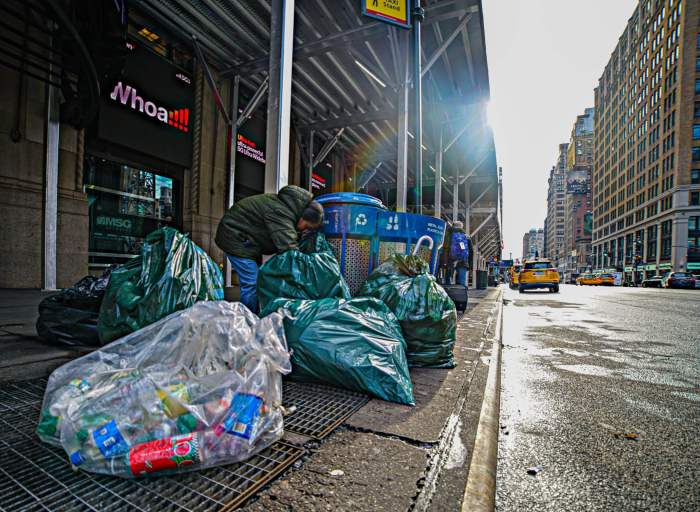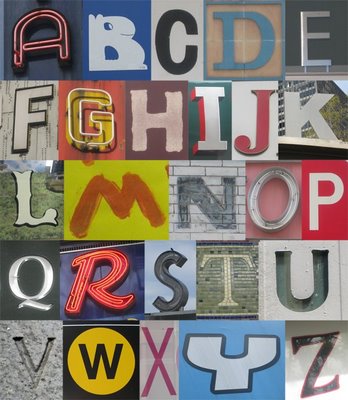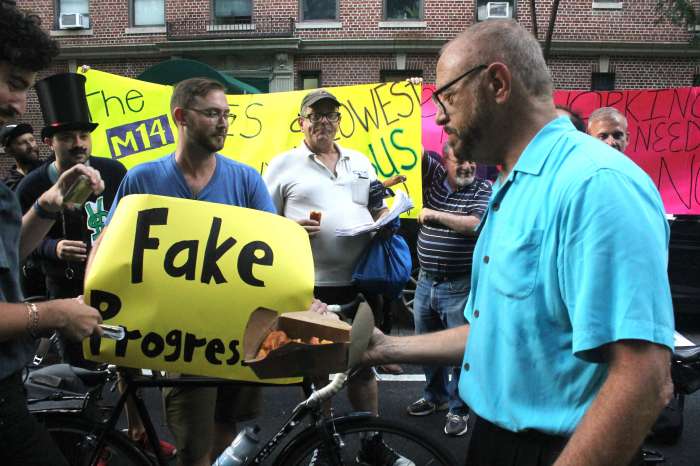Courageous coverage
To The Editor:
Re “With nets, spray and force, police crack down on march” (news article, Sept. 29):
Thank you, Jefferson Siegel, for your courageous Occupy Wall Street coverage. Your on-the-ground, up-close photographs and narrative are superb. Can’t help noticing the contrast with the remoteness of The New York Times’s coverage of Sat., Oct. 1.
Ann Warner Arlen
Occupation elation
To The Editor:
Re “With nets, spray and force, police crack down on march” (news article, Sept. 29):
Thanks, Jefferson! This is the most heartwarming thing to happen to New York City in years! I’m so grateful for the sincerity, courage, compassion and unselfish, committed, beautiful people forming into some kind of community, new society or something of what we could be as a people if we tried…if we wanted…instead of feeling powerless, alienated, isolated, depressed, fearful and downtrodden, as so many of us have for so long. That’s what the system wants us to be — instead of alive, defiant, caring. Love thy neighbor!
I’m meeting people from around the country and my own neighborhood down in “Liberty Square” that I’ve never seen or talked to before. It’s so incredible! Lovely! I hope we find a way to continue this social experiment, this uprising, this gift! What an opportunity to create justice we so badly need!
Priya Warcry
Words vs. action
To The Editor:
Re “With nets, spray and force, police crack down on march” (news article, Sept. 29):
On May 4, Mike Bloomberg promoted a work of sculpture by a jailed Chinese artist, a former New York City street artist, Ai Weiwei.
“This is a message from America to the whole world that we are the place where people can come and express themselves,” Mr. Bloomberg said. “China would be well served to listen to our message and to copy us.”
Mr. Bloomberg, no stranger to criticism as the elected leader of a fractious city, said, “Freedom is our competitive advantage,” and called free expression “the most valuable of all New York City’s riches.”
Are these mass false arrests an example of your ideas about freedom, Mr. Mayor?
Robert Lederman
Lederman is president, ARTIST (Artists’ Response to Illegal State Tactics)
Why process matters
To The Editor:
Re “C.B. 2 angered after N.Y.U. goes to the media first” (news article, Sept. 29):
Alicia Hurley, a New York University vice president, is dismayed by the fixation on “process over substance.” The process she objects to is the democratic one, where voters, taxpayers and elected representatives use the mechanisms of government to evaluate and oppose radical changes to a residential community.
It is not surprising that since the introduction of N.Y.U.’s 2031 plan, process has been continually thwarted, sidestepped or ignored.
N.Y.U. is a billion-dollar, for-profit corporation, with a developer’s dream of 2 million square feet of commercial real estate. Parks, playgrounds, housing and residential quality of life must be sacrificed. So “process” is just another victim of the bulldozer.
Ellen Horan
Who’s not being civil?
To The Editor:
Re “C.B. 2 angered after N.Y.U. goes to the media first” (news article, Sept. 29):
The informative article appearing in last week’s issue about Community Board 2’s anger with N.Y.U. contains a statement from university V.P. Alicia Hurley:
“It is hard for us not to notice the lack of civility with which we are treated when we do go before the community board.”
How civil was it for the university to make a presentation at a meeting where the N.Y.U. presenter had no answers to our questions and, to the best of my knowledge, has not yet answered a letter from C.B. 2 that contained pages of questions?
If we didn’t “fixate” on process over substance, the buildings would all be torn down by now!
Judith Chazen Walsh
Brought back memories
To The Editor:
Re “Samuel Menashe, 85, poet belatedly dubbed a master” (obituary, Sept. 29):
Thank you, Albert Amateau, for that obituary you did on Samuel Menashe. I knew him growing up since he moved into that railroad flat you described in 1956. He lived upstairs from my family’s apartment. I was 6 at the time.
I so much remembered him as a young, articulate and intellectual man. My mother would often sew his buttons and iron his shirts when he would go out to a special event. She would stop him in the hallway and, in her motherly way, say, “Where are you going with that shirt like that?” He would smile and reluctantly take it off and then thank her profusely for her kind deed.
I moved out in 1973 and did not see him until many years later when he was part of a group of residents who were opposing the demolition of the Tunnel Garage on the corner of Thompson and Broome Sts.
Thank you for telling his life story. I had no idea he was such an accomplished poet and had lived such a full life. He was a true gentleman and a wonderful human being.
That poem you quoted at the end really brought back the bathtub in the kitchen with the “cat feet” for me.
Philip Mouquinho
Save Bowery landmark
To The Editor:
Re “City Council, Chin pull the plug on Bowery old-timer” (news article, Sept. 22):
Despite the tremendous outpouring of letters and testimonies from some of our most respected community groups, preservationists, cultural institutions, residents and business leaders, the City Council rushed through a vote to strip 135 Bowery of its designation as a New York City landmark. We’re still reeling from the senseless destruction of 35 Cooper Square, and the Council’s decision is a stunning, cynical deathblow to our city’s oldest thoroughfare.
Ironically, this comes just weeks before the Bowery is expected to be named to the National Register of Historic Places. Located on the most well-preserved stretch of the Bowery, across the street from the iconic Stanford White-designed Bowery Savings Bank and near five other Federal-era structures, 135 Bowery is one of our oldest structures.
Perhaps because she herself submitted testimony favoring the landmarking of 135 Bowery at last year’s hearing, Councilmember Chin did not really address the merits of the Landmarks Preservation Commission’s designation, nor the fact that the Department of Buildings deemed it a sound structure. Chin chose instead to position the issue as a Sophie’s choice in which affordable office space and jobs could be created only if the building is sacrificed for the construction of a tower. The underlying assumption here is that this is the only possible location for an office tower.
Ms. Chin’s concern for small businesses [“Small businesses ask City Council for assistance,” news article, Sept. 22] is welcome, but her aggressive effort to demolish No. 135 will only embolden developers and accelerate the already rapid displacement of the Bowery’s jewelry, lighting and restaurant supply stores. Councilmember Diana Reyna rightly points out that there is a preferential push for new businesses rather than help for the existing small businesses.
Because Ms. Chin speaks of the post-9/11 struggles and knows that tourism is a driving force in our recovery, she should recognize the aesthetic, historical and architectural value in preserving this nearly 200-year-old structure. Since the Bowery is the convergence point for Chinatown, Little Italy, Noho, the East Village and the Lower East Side, maintaining its historic character and resources should thus be obvious to all.
We encourage Councilmember Chin to work for a larger vision that would better serve the entire community. We ask her to work with the building owner, First American International Bank, and preservationists to find another way to preserve 135 Bowery. Given bank C.E.O. Peter Yau’s prominent position as steering committee chairperson of the Chinatown Business Improvement District, the bank should also be working with the community to find a just solution. Because Margaret Chin has heretofore been a strong, helpful ally in the Bowery preservation effort, we trust that she will actively work to find a solution that achieves the goals of all concerned.
Having recently lost 35 Cooper Square, the Bowery must not lose yet another of its historic resources just as it prepares to be named to the National Register of Historic Places.
A correction: 135 Bowery is not the oldest building on the Bowery. That distinction is held by the Edward Mooney house at 18 Bowery at Pell St. Built in 1785, it is Manhattan’s oldest brick house.
David Mulkins
Mulkins is chairperson, Bowery Alliance of Neighbors
E-mail letters, not longer than 250 words in length, to news@thevillager.com or fax to 212-229-2790 or mail to The Villager, Letters to the Editor, 515 Canal St., Suite 1C, NY, NY 10013. Please include phone number for confirmation purposes. The Villager reserves the right to edit letters for space, grammar, clarity and libel. The Villager does not publish anonymous letters.
















